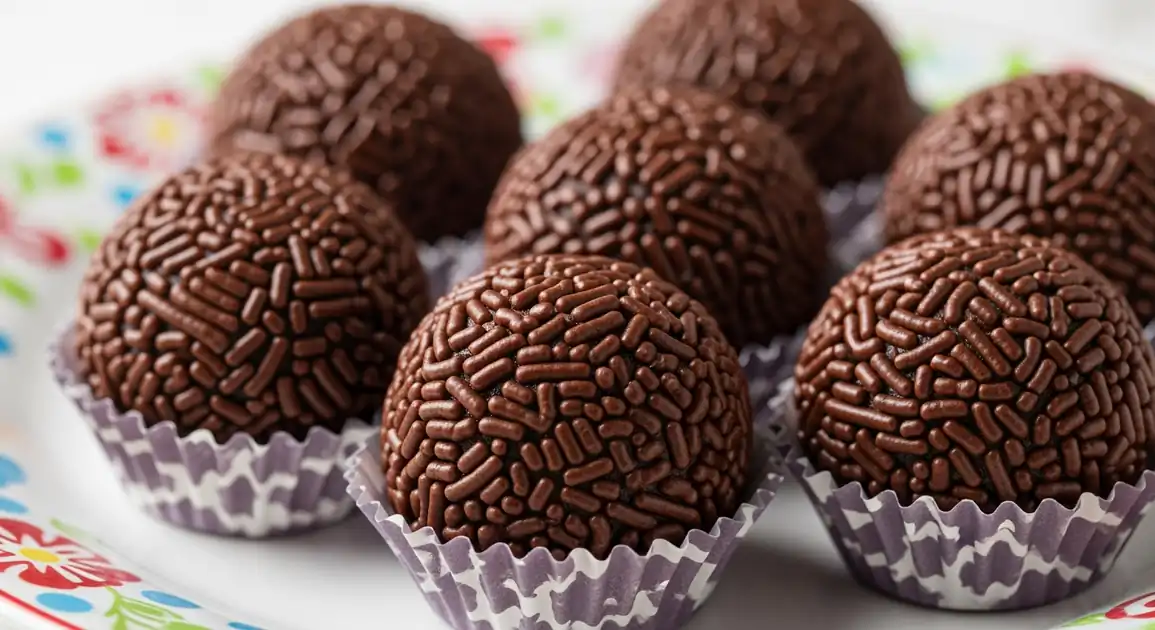Brigadeiro (Brazilian Fudge Ball)
Brigadeiro

Description
Brigadeiros are ubiquitous across Brazil, found everywhere from humble bakeries ('padarias') and supermarkets to sophisticated sweet shops ('docerias') and nearly every birthday party. They are a fundamental part of Brazilian culture and cuisine, enjoyed by all ages year-round.
Dietary Information
Serving information
Serving style
Typically served in small, colorful paper or foil liners ('forminhas'). Eaten by hand in one or two bites. Often presented arranged on platters at events.
Quick facts
Padarias often open early (6 AM - 8 PM). Docerias typically open mid-morning (10 AM - 7 PM or later). Availability at parties is event-dependent.
Safety Tips
What to Look For
-
Glossy, smooth surface
Indicates freshness and that the Brigadeiro hasn't dried out or become stale.
-
Reputable source (bakery, known caterer, fresh batch)
Ensures proper handling, fresh ingredients, and appropriate storage.
-
Served in clean paper liners ('forminhas')
Helps maintain hygiene and prevents sticking.
-
Appropriate temperature
Should be served at room temperature or slightly chilled, not warm or melted.
What to avoid
-
Dry, cracked, or dull appearance
Suggests the Brigadeiro is old and likely stale or improperly stored.
-
Melted or misshapen appearance
Indicates exposure to heat, affecting texture and potentially safety if left out too long.
-
Uncovered Brigadeiros exposed to open air for long periods
Can lead to drying out or potential contamination, especially in busy environments.
-
Suspiciously cheap Brigadeiros from unknown vendors
While often affordable, extremely low prices might correlate with lower quality ingredients or older stock.
Price information
Price range
Budget tips
- Basic chocolate Brigadeiros from padarias are the most affordable (2-4 BRL).
- Buying in bulk for parties often reduces the per-unit cost.
- Supermarket versions can be cheaper but may lack freshness/quality.
Value indicators
- Glossy appearance.
- Soft, fudgy texture (not hard or grainy).
- Good quality sprinkles or toppings.
- Made with good quality condensed milk and real butter (often advertised for gourmet versions).
Where to Find This Dish
Padarias (Bakeries)
Virtually every neighborhood bakery will have brigadeiros at the counter.
Local bakeries in any town/city
Morning (fresh batches), Afternoon
Docerias (Sweet Shops)
Specialty shops offering a wider variety of traditional and gourmet flavors.
Shopping malls, Commercial streets
10 AM - 8 PM (typical shop hours)
Festas Juninas (June Festivals)
Often sold alongside other traditional treats during these winter festivals.
Festival grounds, Community centers
June/July evenings
Vendor Tips
- Look for shops specializing in 'docinhos' (little sweets) for higher quality and more variety.
- Ask if they are made with real butter ('manteiga') vs margarine.
- For gourmet versions, ask about the type of chocolate used.
How to Order
Regional Variations
-
Beijinho de Coco
(Beijinho de Coco)
'Little Kiss of Coconut'. Made with condensed milk and coconut flakes instead of cocoa, rolled in granulated sugar or more coconut flakes, often topped with a clove.
-
Cajuzinho
(Cajuzinho)
'Little Cashew'. Traditionally made with condensed milk, ground roasted peanuts (though named cashew), and cocoa powder, rolled in sugar and shaped like a cashew, often topped with a peanut.
-
Bicho de Pé
(Bicho de Pé)
'Foot Bug' (playful name). Strawberry flavored brigadeiro, pink in color, usually rolled in granulated sugar.
-
Brigadeiro Gourmet
(Brigadeiro Gourmet)
Modern variations using high-quality chocolate (e.g., Belgian), different fats (e.g., heavy cream), and diverse toppings like chopped nuts (pistachios, almonds), chocolate shavings, edible glitter, or flavored sprinkles.
-
Brigadeiro Branco
(Brigadeiro Branco)
'White Brigadeiro'. Made without cocoa powder, using just condensed milk and butter, often rolled in powdered milk or white chocolate sprinkles.
Cultural context
History
The Brigadeiro's origin is popularly linked to the 1940s presidential campaign of Brigadeiro (Brigadier) Eduardo Gomes. Supporters supposedly created and sold the sweet to raise funds, naming it in his honor. While the exact details are debated, the treat quickly captured the hearts (and taste buds) of Brazilians and became deeply ingrained in the culture, symbolizing celebration and simple pleasures.
Local significance
The Brigadeiro is arguably Brazil's most iconic sweet. It represents celebration, childhood nostalgia, comfort food, and national pride. It's more than just a dessert; it's a cultural symbol.
Eating customs
- Consumed casually by hand.
- Usually served towards the end of a party, alongside the cake.
- Often accompanied by coffee.